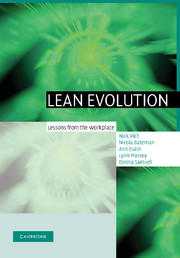Book contents
- Frontmatter
- Contents
- List of boxes
- List of figures
- List of tables
- Glossary
- 1 Introduction
- 2 Understanding the lean journey
- 3 Understanding your organisation
- 4 Laying the foundation stone of CANDO
- 5 Visual management and performance measurement
- 6 Problem solving, TQM and Six Sigma
- 7 Pull systems
- 8 Total productive manufacturing (TPM)
- 9 Sustainability
- 10 Group learning
- 11 Reflections and future challenges
- References
- Index
10 - Group learning
Published online by Cambridge University Press: 17 August 2009
- Frontmatter
- Contents
- List of boxes
- List of figures
- List of tables
- Glossary
- 1 Introduction
- 2 Understanding the lean journey
- 3 Understanding your organisation
- 4 Laying the foundation stone of CANDO
- 5 Visual management and performance measurement
- 6 Problem solving, TQM and Six Sigma
- 7 Pull systems
- 8 Total productive manufacturing (TPM)
- 9 Sustainability
- 10 Group learning
- 11 Reflections and future challenges
- References
- Index
Summary
Introduction
This final part of the book heralds something of a departure from what has preceded. Now that we have addressed the key elements of lean transformation we turn to slightly more reflective issues. In the last chapter we considered an organisation's ability to sustain change over time and this chapter addresses organisational learning, particularly in the context of a group. The final chapter outlines our reflections and deliberations at the end of the research programme and indeed at the end of the process of producing this book. Although slightly more cerebral in nature, we do try to present these matters in the down-to-earth and practically oriented style to which you have by now become accustomed.
Let us be absolutely clear at the outset about what we mean by learning and why it matters. The purpose of learning is not the accumulation of knowledge for its own sake, but rather to bring about behavioural change (Pedler et al., 2003). The ability to learn new skills, to apply them and to embed them into everyday behaviour is what sustainable change is all about. It all begins with learning. For a lean transformation to successfully take place, learning is required at the operational level of the organisation, at the level of the value stream and, most definitely, at the strategic level (Dimancescu et al., 1996). In the previous chapter you saw how learning determines the ability to achieve different degrees of sustainability.
- Type
- Chapter
- Information
- Lean EvolutionLessons from the Workplace, pp. 185 - 199Publisher: Cambridge University PressPrint publication year: 2006



